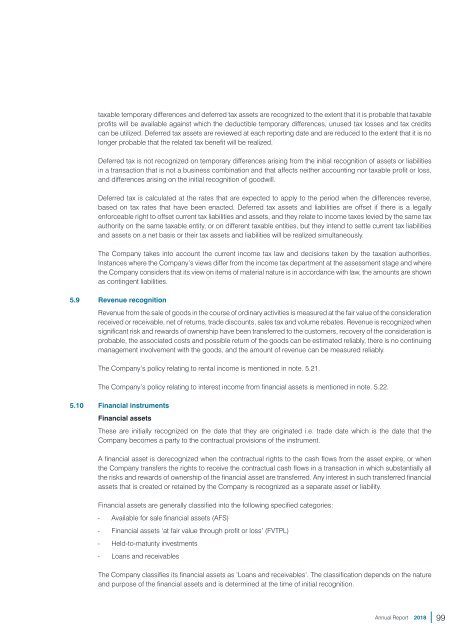MS AR 2018 (1)
Create successful ePaper yourself
Turn your PDF publications into a flip-book with our unique Google optimized e-Paper software.
taxable temporary differences and deferred tax assets are recognized to the extent that it is probable that taxable<br />
profits will be available against which the deductible temporary differences, unused tax losses and tax credits<br />
can be utilized. Deferred tax assets are reviewed at each reporting date and are reduced to the extent that it is no<br />
longer probable that the related tax benefit will be realized.<br />
Deferred tax is not recognized on temporary differences arising from the initial recognition of assets or liabilities<br />
in a transaction that is not a business combination and that affects neither accounting nor taxable profit or loss,<br />
and differences arising on the initial recognition of goodwill.<br />
Deferred tax is calculated at the rates that are expected to apply to the period when the differences reverse,<br />
based on tax rates that have been enacted. Deferred tax assets and liabilities are offset if there is a legally<br />
enforceable right to offset current tax liabilities and assets, and they relate to income taxes levied by the same tax<br />
authority on the same taxable entity, or on different taxable entities, but they intend to settle current tax liabilities<br />
and assets on a net basis or their tax assets and liabilities will be realized simultaneously.<br />
The Company takes into account the current income tax law and decisions taken by the taxation authorities.<br />
Instances where the Company’s views differ from the income tax department at the assessment stage and where<br />
the Company considers that its view on items of material nature is in accordance with law, the amounts are shown<br />
as contingent liabilities.<br />
5.9 Revenue recognition<br />
Revenue from the sale of goods in the course of ordinary activities is measured at the fair value of the consideration<br />
received or receivable, net of returns, trade discounts, sales tax and volume rebates. Revenue is recognized when<br />
significant risk and rewards of ownership have been transferred to the customers, recovery of the consideration is<br />
probable, the associated costs and possible return of the goods can be estimated reliably, there is no continuing<br />
management involvement with the goods, and the amount of revenue can be measured reliably.<br />
The Company’s policy relating to rental income is mentioned in note. 5.21.<br />
The Company’s policy relating to interest income from financial assets is mentioned in note. 5.22.<br />
5.10 Financial instruments<br />
Financial assets<br />
These are initially recognized on the date that they are originated i.e. trade date which is the date that the<br />
Company becomes a party to the contractual provisions of the instrument.<br />
A financial asset is derecognized when the contractual rights to the cash flows from the asset expire, or when<br />
the Company transfers the rights to receive the contractual cash flows in a transaction in which substantially all<br />
the risks and rewards of ownership of the financial asset are transferred. Any interest in such transferred financial<br />
assets that is created or retained by the Company is recognized as a separate asset or liability.<br />
Financial assets are generally classified into the following specified categories:<br />
- Available for sale financial assets (AFS)<br />
- Financial assets ‘at fair value through profit or loss’ (FVTPL)<br />
- Held-to-maturity investments<br />
- Loans and receivables<br />
The Company classifies its financial assets as ‘Loans and receivables’. The classification depends on the nature<br />
and purpose of the financial assets and is determined at the time of initial recognition.<br />
Annual Report <strong>2018</strong><br />
99


